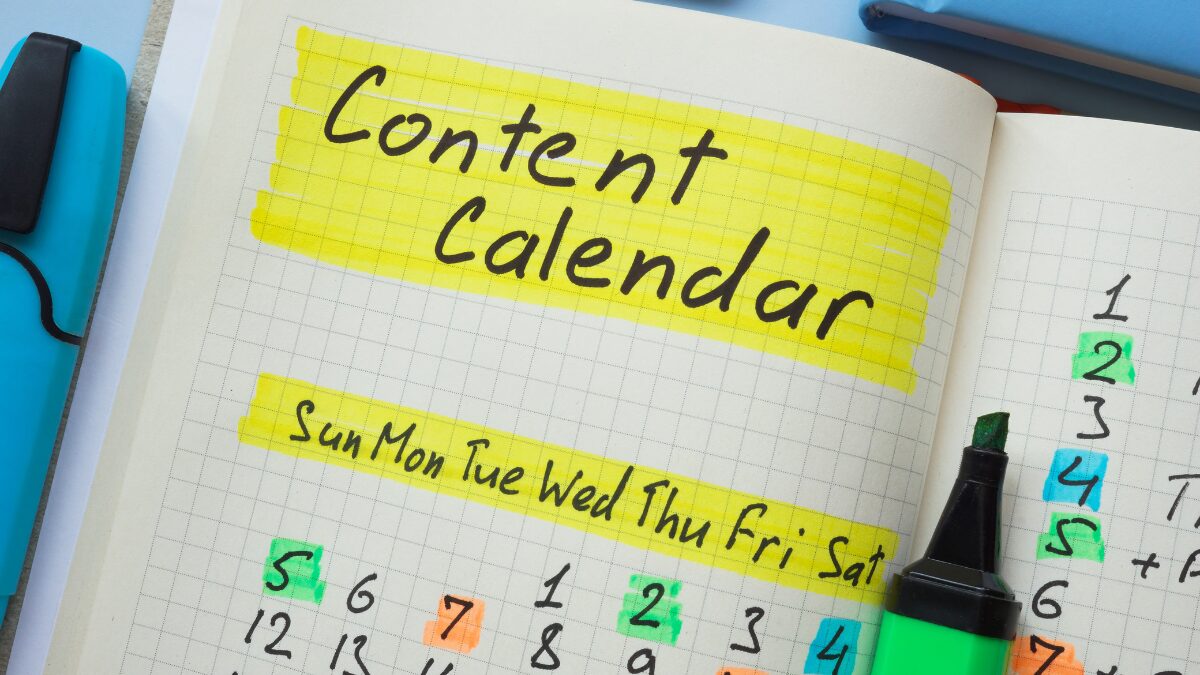How to create a marketing content calendar: the ultimate guide

As a marketer, you know how important it is to consistently produce high-quality content to build a strong brand identity and engage your audience. However, it can be challenging to stay organized and aligned with your marketing goals. This is where a content calendar comes in.
A content calendar helps you plan, organize, and track your content efforts so that you can deliver the right content to your customers at the right time.
This guide will cover the benefits of using a content marketing calendar and provide a step-by-step process for creating one. Whether you’re an experienced marketer or just starting your content journey, this resource will give you the knowledge to enhance your content strategy.
What is a content calendar?
A content calendar, also known as an editorial calendar, is a strategic planning tool that you can use to schedule and organize your content creation and distribution across various channels.

Your content calendar serves as a central hub, bringing together the likes of your:
- Social media calendar
- Blog calendar
- Email marketing schedule
It offers a complete overview of your content strategy, enabling you to synchronize and coordinate various marketing activities across multiple platforms and channels.
Why are content calendars important?
When it comes to improving marketing results, having a solid plan makes all the difference and a content calendar can be your roadmap to success (literally). Let’s take a look at the key benefits of switching to calendarized content, and how it can transform your marketing efforts.
Improved organization
Creating content at the last minute can be chaotic. Planning your content in the form of a calendar helps you avoid stress and last minute rushes. It also allows you to think about all the content you’ll be producing across the month, quarter, or even year in a joined up and connected way. This allows you to create content journeys, rather than ad-hoc one of pieces, which immediately improves searchability and the customer experience. You’ll also have a clear view of what needs to be done and when, allowing for a smoother workflow and the ability to approach each piece of content with intention and purpose.
Increased consistency
Consistency goes hand in hand with engagement. When you stick to a regular publishing schedule your audience knows when to expect new content from you, which keeps them coming back for more. Whether it’s weekly blog posts or daily email updates, a consistent rhythm builds trust and loyalty among your audience.
Better collaboration
A content marketing calendar can also help with cross-team collaboration. When everyone has access to the same calendar, it becomes much easier to align your content strategy. Team members can see what others are working on, share ideas, and coordinate efforts without stepping on each other’s toes. This transparency leads to more cohesive content that reflects your brand’s voice and goals.
Enhanced efficiency
A well-planned content marketing calendar doesn’t just help with organization; it also boosts efficiency. By mapping out your content in advance, you can optimize your resources and avoid wasting time on last-minute tasks. So you can focus on creating high-quality content rather than scrambling to meet deadlines.
Improved SEO
Let’s not forget about the search engines. By strategically planning your content around relevant keywords and topics, you can enhance your SEO efforts. A content calendar allows you to think ahead about how each piece will fit into your overall SEO strategy, helping improve your website’s visibility over time. With thoughtful planning, you’ll not only engage your audience but also attract new visitors through organic search.
How to create a content marketing calendar
Creating a content calendar simply requires a clear process. Here’s a step-by-step guide to creating an effective calendar.

1. Define your goals
Before getting stuck into the details of your calendar, first clarify your marketing goals. Are you aiming to:
- Increase brand awareness?
- Generate leads?
- Boost engagement?
Having clear objectives will help you shape your content strategy.
2. Identify your target audience
Next, define your target audience. Who is your content intended for? Understanding audience preferences, challenges, and interests will enable you to customize your content to effectively meet their needs.
3. Conduct keyword research
Keyword research helps you identify the search terms that your target audience is using. This information can be used to optimize your content for search engine results pages (SERPs) and attract more organic traffic. This is particularly valuable for blog posts and paid advertising campaigns.
4. Create your content calendar template
Selecting the ideal content calendar tool depends on your team’s size, workflow, and specific needs but you don’t need to overcomplicate it. Many marketers start with simple spreadsheets like Google Sheets or Excel, which are easy to customize and share across teams. If you need more advanced features, consider digital platforms that let you schedule, track, and collaborate in real time.
Or, if you’d like a ready-to-use template and examples of tools that work for different teams, our content marketing plan can help too.
5. Brainstorm content ideas
With your goals, audience, and schedule in place, it’s time to brainstorm content ideas. Gather your team for a brainstorming session or use tools like Google Trends and AnswerThePublic to identify trending topics in your industry.
Consider creating a mix of evergreen content (topics that remain relevant over time) and timely pieces (content related to current events or trends). This variety will keep your audience engaged throughout the year.
6. Determine your content types and channels
Next, decide on the types of content you want to create. Some content types you may want to include are:
- SMS messages
- Email newsletters
- Blog posts
- Videos
- Infographics
- Ebooks
- Webinars
- Social media posts
- Case studies
Also, think about where you’ll distribute this content. Different channels may require different types of content. For example, social channels like Instagram and LinkedIn are more visual than longer form channels like blogs and emails. By outlining both your content types and channels upfront, you can ensure a balanced approach.
7. Map out your content
Now comes the fun part; populating your calendar! Start filling in specific content pieces based on your brainstorming session. Include:
- Publication dates: When will each piece go live?
- Content types: What format will it take?
- Titles or topics: What will you write about?
This is also a good time to assign responsibilities—who will write it? Who will edit it?
8. Establish a posting schedule
How often do you want to publish new content? Setting a posting schedule supports consistency. Consider factors like:
- Your team’s capacity
- Audience preferences (e.g., do they prefer daily updates or weekly deep dives?)
- Industry standards (how often do competitors post?)
Once you have a frequency in mind (e.g., three blog posts per week or two emails a week) you can start mapping out when each piece will go live.
9. Include key details
For each piece of content in your calendar, include essential details such as:
- Target keywords: What keywords are you aiming to rank for?
- Content or email brief: A short outline or description of what the piece will cover.
- Calls-to-action: What action do you want readers to take after engaging with the content?
- Visual assets needed: Will you need images or graphics? Note those down.
These details will help streamline the creation process and ensure everyone knows what’s expected.
10. Build in flexibility
While having a plan is great, it’s equally important to remain adaptable. Leave some open slots in your calendar for timely or reactive content, this way you can jump on trends or address current events as they arise without disrupting your entire schedule.
11. Review and adjust regularly
A content marketing calendar isn’t set in stone; it should evolve as your business needs change. Schedule regular reviews, monthly or quarterly, to assess what’s working and what isn’t. Look at performance data to see which types of content resonate most with your audience and adjust accordingly.
Some common mistakes to avoid
Even the best marketing calendars can hit some bumps. Here are some of the most common pitfalls and how to avoid them:
Skipping audience research:
A content calendar is only as effective as your understanding of your audience. Make sure every piece of content aligns with what your audience cares about.
Overloading your schedule:
More isn’t always better. Don’t cram in every idea at once. Focus on quality and consistency rather than quantity.
Ignoring key dates and events:
Seasonal campaigns, product launches, or industry events can make or break engagement. Missing these opportunities can leave your calendar feeling flat.
Not reviewing performance regularly
Your calendar should evolve with your results. Check what’s working, what’s not, and adjust your plan accordingly.
Neglecting cross-channel coordination:
If your email, social, and blog teams aren’t aligned, your messaging can feel disjointed. Keep everyone in the loop to maximize impact.
Forgetting to plan for flexibility:
Marketing never goes exactly to plan. Leave room for spontaneous campaigns, trending topics, or last-minute updates.
Taking the time to avoid these mistakes can make your content marketing calendar a powerful tool, rather than just a to-do list.
How to use a content calendar to improveyour email marketing strategy
A content calendar can significantly enhance your email marketing strategy by helping you plan, execute, and optimize your campaigns more effectively. Here’s how you can use your content calendar to boost your email marketing efforts:
Plan email campaigns in advance
Utilize your content calendar to schedule regular newsletters, promotional emails, and drip campaigns well in advance. This forward-thinking approach ensures a steady flow of communication with your audience and allows you to align your email content with other marketing initiatives.
Maintain consistent communication
With a content calendar, you can establish and maintain a regular cadence for your email communications. This consistency helps build anticipation among your subscribers and keeps your brand top-of-mind.
Segment your audience
Plan different email streams for various subscriber segments within your calendar. This allows you to tailor content to specific interests, behaviors, or stages in the customer journey, increasing the relevance and effectiveness of your emails.
Optimize send times
Make use of your calendar to test different sending times and days. You can utilize Dotdigital’s send-time optimization to determine the ideal time to send, based on your contacts’ past click behavior. It will then schedule individual sends at this time to maximize engagement.
Balance content types
Your content calendar helps you maintain a healthy mix of email content. Plan to mix promotional emails with value-added content like tips, industry news, and exclusive insights. This variety keeps your audience engaged and positions your brand as a valuable resource.
Incorporate seasonal themes
Map out emails around holidays, industry events, or seasonal trends relevant to your audience. Your content calendar allows you to plan these timely campaigns well in advance, ensuring you don’t miss important opportunities to connect with your subscribers.
Schedule A/B tests
Plan regular A/B tests for subject lines, email content, and calls-to-action. You can improve your email performance over time by scheduling these tests in your content calendar.
Coordinate with other marketing efforts
Use your calendar to align your email content with your overall marketing strategy. This ensures that your email messages complement and reinforce content shared across other channels, creating a more cohesive brand experience.
Quick tip
Remember to integrate your email marketing strategy into your content calendar. This will help you create a more strategic, data-driven approach to engaging your audience through email. Planning and coordinating at this level will improve key email marketing metrics, such as higher open rates, improved click-through rates, and ultimately, better conversion rates for your email campaigns.
How Dotdigital enhances your marketing strategy
Here’s how Dotdigital helps you distribute your content across key channels:
Email marketing
Dotdigital’s email marketing tools allow you to execute your email content strategy seamlessly. You can schedule and automate email campaigns aligned with your content calendar, ensuring timely delivery of newsletters, product updates, and promotional content to your subscribers’ inboxes.
SMS messaging
Extend your reach beyond email with Dotdigital’s SMS capabilities. Integrate SMS messaging into your content calendar to deliver time-sensitive updates, exclusive offers, or reminders directly to your audience’s mobile devices, enhancing engagement and immediacy.
Web personalization
Leverage Dotdigital’s web personalization features to dynamically adjust your website content based on visitor behavior and preferences. This allows you to display tailored content, product recommendations, and offers that align with your overall content strategy, creating a cohesive experience across channels.
Social retargeting
Amplify your content’s impact through Dotdigital’s social retargeting capabilities. Synchronize your social media advertising efforts with your content calendar and retarget website visitors or email subscribers with relevant content on social platforms.
Cross-channel automation
Dotdigital’s automation features enable you to schedule content across multiple channels. This automation ensures your content reaches your audience at the right time, as planned in your content calendar.
Create your content calendar today
Creating and maintaining a marketing content calendar is a powerful way to streamline your content marketing efforts and achieve better results. Following the steps and strategies outlined in this guide, you can develop a content calendar that keeps your team organized, your content consistent, and your marketing goals on track.
Remember that your content calendar should be a living document, evolving as your business grows and your audience’s needs change. Regularly review and refine your approach to ensure that your content calendar remains an effective tool for driving your marketing success.
With a well-planned content calendar, you’ll be better equipped to create high-quality, strategic content that resonates with your audience and supports your business objectives. So start planning, stay consistent, and watch your content marketing efforts flourish.



